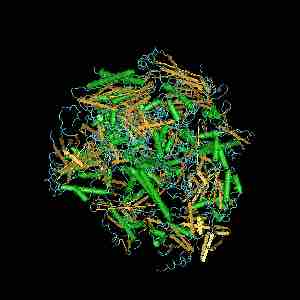Verrucomicrobia is a recently described phylum of bacteria which is part of the PVC superphylum. The PVC group includes Chlamydiae, Lentisphaerae, Planctomycetes, Verrucomicrobia, Poribacteria and OP3. Support for this superphylum has been found by examining the RNA polymerase protein RpoB.

RNA polymerase II
RNA polymerase II (also called RNAP II and Pol II) is an enzyme found in eukaryotic cells. It catalyzes the transcription of DNA to synthesize precursors of mRNA and most snRNA and microRNA.
rpoB is the gene that encodes the β subunit of bacterial RNA polymerase. This protein has a unique 3 amino acid insert in all sequenced Chlamydiae, Lentisphaerae and Verrucomicrobia species. In addition, a conserved protein of unknown function is present in all sequenced species from the phyla Chlamydiae, Lentisphaerae, Planctomycetes and Verrucomicrobia. This protein is absent in the Poribacteria. Study of additional proteins from this proposed superphylum suggests that the Poribacteria may be separate from this clade. The Planctomycetes may be basal to the Chlamydiae-Verrucomicrobia-Lentisphaerae clade.
Like the Planctomycetes species, Verrucomicrobia possess a compartmentalised cell plan with a condensed nucleoid and the ribosomes pirellulosome (enclosed by the intracytoplasmic membrane) and paryphoplasm compartment between the intracytoplasmic membrane and cytoplasmic membrane. Cavalier-Smith has postulated that the Verrucomicrobia belong in the clade Planctobacteria in the larger clade Gracilicutes. 16S rRNA data corroborate that view. In 2008, the whole genome of Methylacidiphilum infernorum (2.3 Mbp) was published. On the single circular chromosome, 2473 predicted proteins were found, 731 of which had no detectable homologs. These analyses also revealed many possible homologs with Proteobacteria.
Evidence suggests that verrucomicrobia are abundant within the environment, and are important especially to soil cultures. Verrucomicrobia have been isolated from fresh water, soil environments and human feces. A number of as-yet uncultivated species have been identified in association with eukaryotic hosts including extrusive explosive ectosymbionts of protists and endosymbionts of nematodes residing in their gametes. While verrucae is another name for the warts often found on the hands and feet, this phylum is so called not because it is a causative agent thereof, but because of its wart-like morphology.